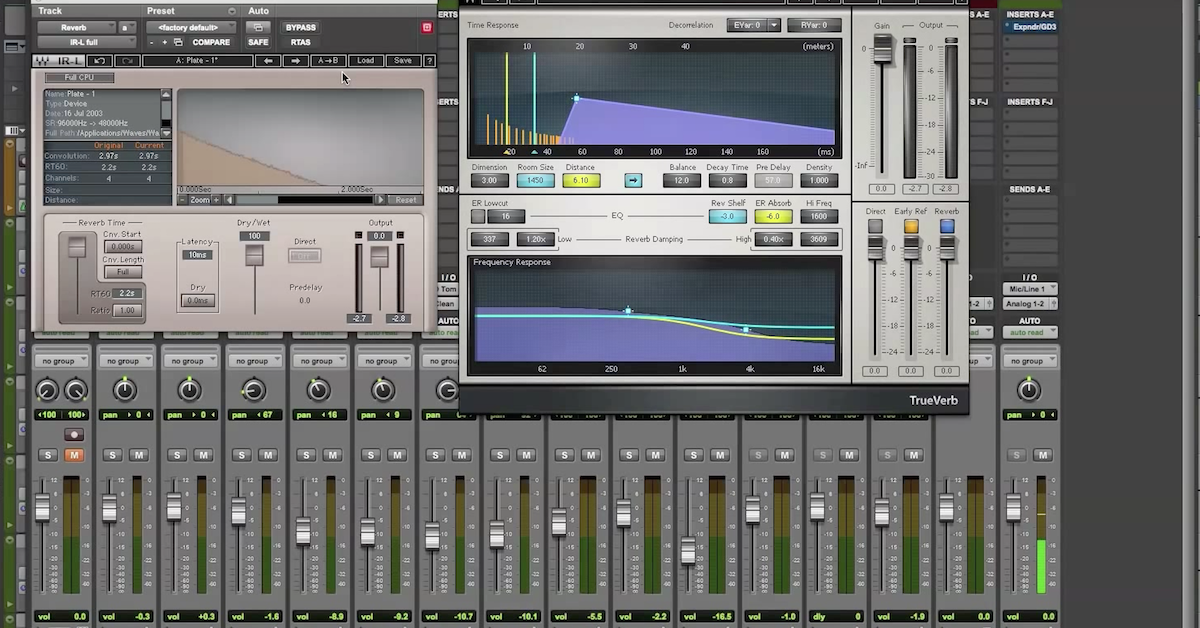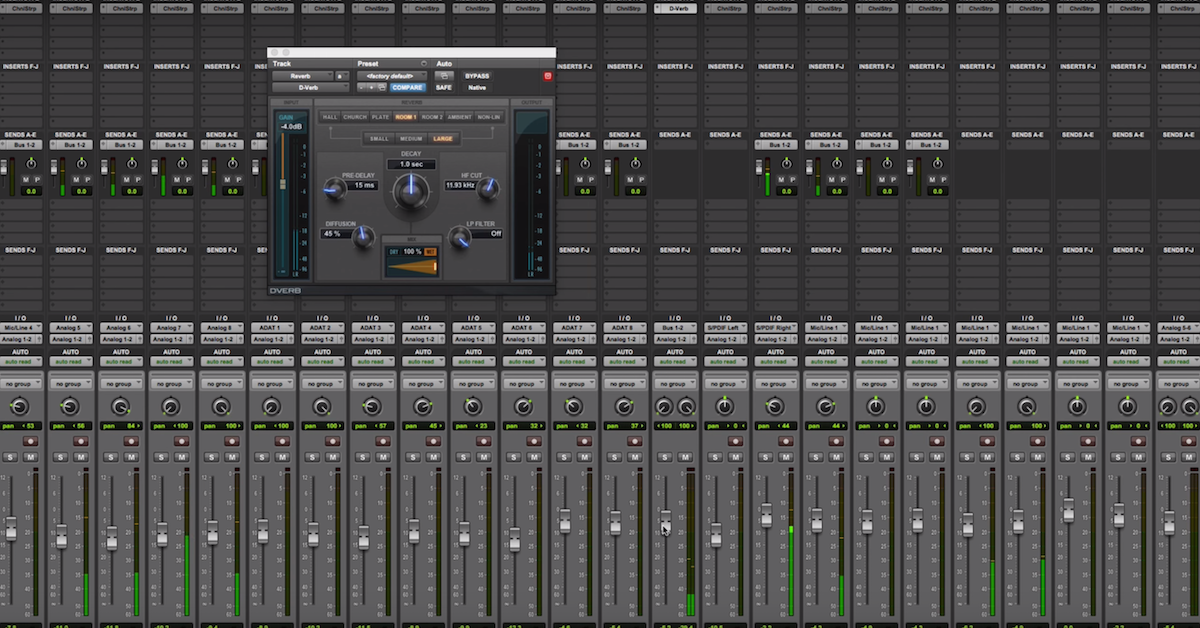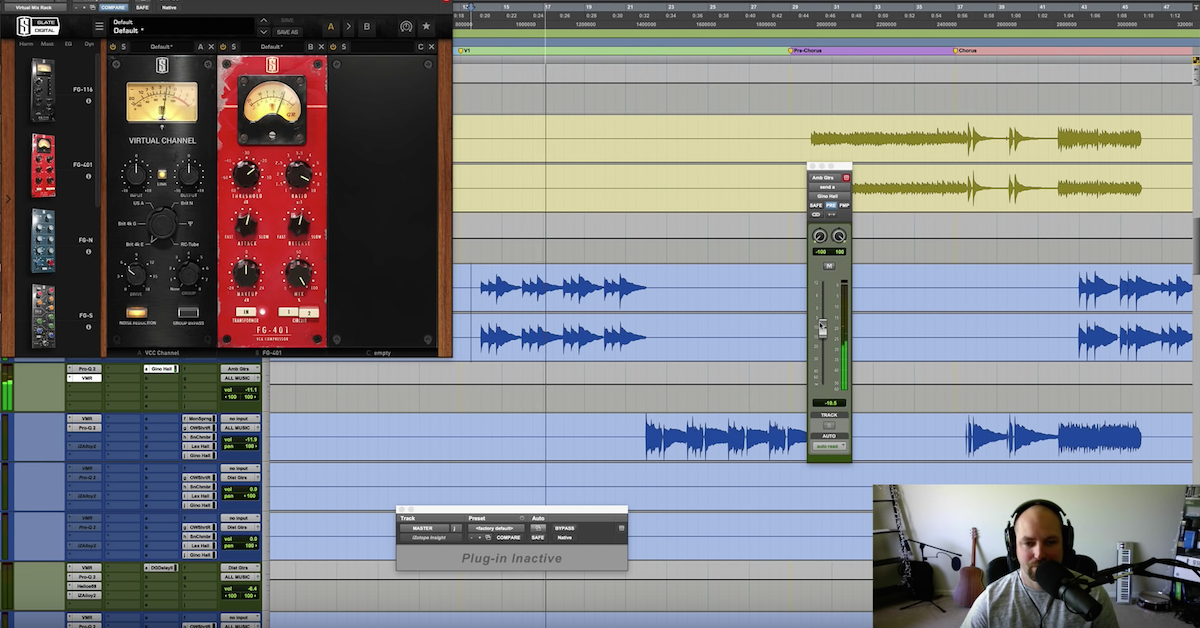5 Different Types of Reverb Explained
Article Content
We’re all different as engineers and music producers. Amongst our vast array of differences, however, there are some striking similarities. We all cringe at the word “exposure”, we all eventually become coffee addicts and we all go through a steep learning curve when it comes to reverb.
I am going to go as far as to admit that there may have been a time in my life when I thought a “Hall” reverb referred to a hallway. What? It’s a very understandable mistake if you have no idea what a hallway sounds like.
If you’re somewhat new to the production world (and maybe even if you aren’t), popping open that reverb algorithm can be a bit daunting. Even if we just ignore the finer controls, just knowing what different “types” of reverbs mean and what to expect from them can be confusing.
Fortunately, you’ve Googled your way here and I can help!
The basic idea is this: a reverb processor is a device that uses an algorithm (magical math) to turn a source sound into the reverberant version of that sound. That algorithm can be configured in a large number of ways, but the designers generally like to set up some basic configurations that imitate the typical reverbs that we frequently come across. Customarily, the reverb types are Rooms, Halls, Chambers, Plates, and Ambiences.
The fun part is that every algorithm is different and every designer’s interpretation of how to imitate each type is completely subjective. The good news is that there are some commonalities that are generally agreed upon that can help hedge our expectations.
1. Room Reverb

uh… not *that* Room
Our most basic reverb type is a room. A room is a space with walls. Doesn’t get much simpler than that. You are probably reading this article while you are in a room right now. Yup, take a good look around, that’s a room.
Rooms come in many shapes and sizes. Your living room is one room, the central space of a cathedral is another room and an underground parking garage — also a room. Your living room is probably fairly small and walled in wood and/or drywall. The cathedral is probably pretty friggin’ big and might be made out of marble. The parking garage is probably wide, with a low ceiling and made of concrete. What you’ll notice is that all of these spaces sound completely different. But, there are a few similarities.
The first is that rooms are designed for shelter and for people to exist, but not specifically for great sound. As a result, unless you happen to be in a Frank Loyd Wright house, rooms tend to have practical shapes such as flat surfaces and parallel walls. These flat, parallel, reflective boundaries cause sonic anomalies such as modal interference, standing waves, flutter echo, rings and resonances. Simply put — they tend to have a distinct colored character.
There’s a lot of “imperfection” in the sound of a room — but it’s exactly those imperfections that can make them compelling. Let’s be honest, who hasn’t wanted to record drums in a parking garage? And your friend’s acoustic guitar might actually sound pretty good in that living room.
Rooms give a natural color and liveliness to a sound. They also sound like a more intimate space and can give the impression that all of the music is being played right in front of you. When we’re going for a natural, in-person, live kind of sound (a pretty common goal in acoustic styles of music like Folk and Jazz), room reverb is a good choice.
2. Hall Reverb
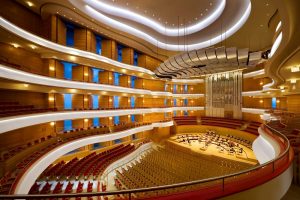
A cat fart probably sounds like the voice of the almighty here. Imagine string ensemble mmm.
I mentioned that rooms are designed for practical purposes and not with the goal of fantastic sound in mind. What if I told you there are rooms out there that are designed exactly with the goal of incredible sound in mind?
Concert Halls are spaces that are dedicated to the enjoyment of music. They’re built to specifically have minimal room modes, echoes, rings, etc., and intended to sound as tonally even as possible (although some are built to amplify lower frequencies to give an orchestra a more grandiose sound). And many halls are built to help propagate the sound, which is why many halls are bow shaped.
Halls are the sound of class. Diamond sequins, Stradivarius violins, a Fazioli pianoforte and possibly Barbara Streisand would all be at home in a concert hall. That Folk band I was talking about in the previous segment, not so much. They’re the salt-of-the-earth, homespun people who don’t see much use in putting on airs. So, they’re happy with vibey room reverb. Celine Dion, she likes a perfect, lush sounding hall.
3. Chamber Reverb
Chambers are kind of the opposite end of the spectrum from halls.
Once upon a time, before digital reverb units, there lived a humble recording studio owner. And this studio owner wanted the sound of a vast reverberant space. Unfortunately, real estate being expensive, this studio owner did not have the resources for a giant hall. So he dedicated a smaller room with very reflective surfaces and preferably oblong angles to the task. Because this smaller room was especially reflective, the reverb tailed on and on when sound was ported in through a speaker. Unfortunately, because the room was small and full of dense echoes, the room had a particularly uneven timbre. Fortunately, people like quirky, vibey stuff.
And thus, the Chamber reverb was born.
Now admittedly, that story is a bit embellished. There’s obviously no such thing as a humble studio owner — but that’s more or less how it happened. Chambers have a ton of color and texture and can sound great on all sorts of sources. Anything that needs a distinct bump in energy or extra texture can benefit. Chambers were largely used on older R&B and Classic Rock records, so if that’s the vibe you’re going for — fire up that reverb.
4. Plate Reverb
And this brings us to one of the most breathtaking reverb sounds of them all: a sheet of metal hanging in a box.
Ok, that’s a bit of an understatement — it’s more than that. There’s also a tiny driver and two pickups. I really feel like I should be saying more, but there isn’t much more to say.
There are some interesting qualities to plate reverbs. A sheet of metal is a two-dimensional space. In a three-dimensional space, there are discrete echoes at the front of the reverb tail and as the reverb tails out the echo density increases. In a two-dimensional sheet, the echoes are the same density from the start of reverberation to the end.
Because the speed of sound is much faster in metal than air, plates have a higher “echo” density. These two factors are what give plates their signature “smooth” reverb tails. Lastly, the higher frequency tones exhaust their energy much faster than lower tones, while lower tones actually take longer to build up. This creates the effect of higher frequencies living at the front of the reverb tail while lower frequencies tail out later on. In other words: metal doesn’t just look shiny, it also sounds shiny.
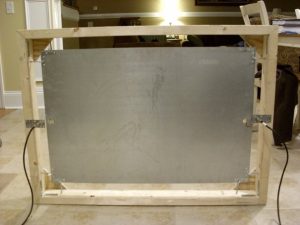
so very sexy
This all makes plates useful for a wide number of sounds. Because of the even distribution of echoes in the tail, plates tend to get along very nicely with other reverbs.
If you happen to have a drum kit, with a couple of room mics, you can probably sneak a plate reverb onto the snare and toms and still have a cohesive sounding kit. This may not be as true if you were to throw an additional room reverb on the snare. Then you get these two different rooms at the same time sounding like the plot of Inception to your ear. Plates are also great at bringing a subtle “pop” or brightness to a sound source, making them ideal for pop vocals, acoustic guitars and really anything else for that matter.
5. Ambiences
Ambiences are the real deal when it comes to digital algorithms. The reality is that an algorithm isn’t a room, hall or a plate. An algorithm is its own thing. Just like how a chamber isn’t really a hall and a plate isn’t a room.
Algorithms sound like what they emulate, but not the same. The word ambience really just refers to ambiguous space around something. In my mind, this is actually where reverb algorithms shine.
Conventionally, ambiences will refer to very short reverbs with any sort of setup the designer deems worthy. That can mean a reverb that’s all early-reflections, late-reflections, highly diffuse, highly non-diffuse, whatever — as long as it’s indistinct.
While that might sound unexciting, it’s actually perfect for sounds that already have a ton of character and dense harmonics like synths. The shortest ambiences are great for any source that you want to sound dry, but still have a sense of three-dimensionality (like rap vocals).
Bonus: Non-Linear Reverb
There’s also a style of reverb exclusive to the digital domain called a Non-Linear Reverb. Like Ambiences, these reverbs are sort of non-categorizable but with one key difference. In all other forms of reverb, as the tail rings out energy is dissipated and the echoes become quieter and quieter.
In a Non-Linear reverb, the echoes can swell up before tailing out or even crescendo until the very last set of echoes. This doesn’t happen in reality, but can be a very cool effect in the musical world.
Non-Linear reverbs can create a rhythmic feel when returned from drums, act like a slapback on guitars and work well on sounds that you might want to keep in-your-face while still having a distinct reverb sound on them.




